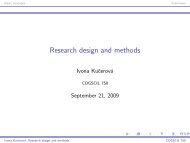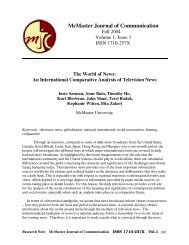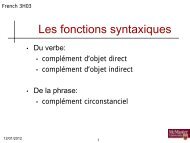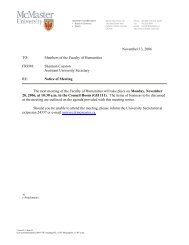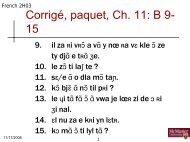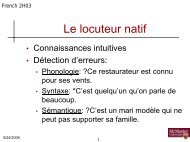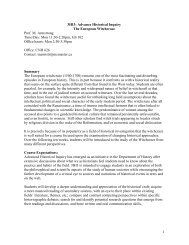The Syntax of Givenness Ivona Kucerová
The Syntax of Givenness Ivona Kucerová
The Syntax of Givenness Ivona Kucerová
Create successful ePaper yourself
Turn your PDF publications into a flip-book with our unique Google optimized e-Paper software.
Peter<br />
gave G to-Mary book<br />
c. G-operator and local G-movement:<br />
Peter gave book G to-Mary<br />
d. G-operator and non-local G-movement:<br />
book G gave Peter to-Mary<br />
<strong>The</strong> evaluation <strong>of</strong> the reference set in (78) is schematized in (79).<br />
(79) Evaluation <strong>of</strong> the reference set <strong>of</strong> (77):<br />
Reference set SYNTAX INTERPRETATION<br />
a. ̌ fails<br />
b. ̌ fails<br />
c. ̌ fails<br />
d. ̌ ̌<br />
<strong>The</strong> candidates in (78-a) and (78-b) pattern with the candidates in (75-a) and (75-b). Thus<br />
they fail because the direct object is not marked as given. <strong>The</strong> candidate in (78-c) is different:<br />
it is syntactically well-formed and the direct object is marked as presupposed. <strong>The</strong><br />
problem with this candidate is that the G-operator marks not only the direct object as presupposed<br />
but also the structurally higher new elements. <strong>The</strong> reason is that there is no early<br />
terminating point for the operator (the structure is in the past tense and there is no auxiliary).<br />
Thus, the object is forced to move above all the new elements. <strong>The</strong> cyclic G-movement is<br />
licensed in this case because the relevant interpretation is not available otherwise.<br />
Notice that while in the previous discussion we needed to refer to the presence <strong>of</strong> a new<br />
element asymmetrically c-commanding the given element, no such constraint is needed<br />
anymore. <strong>The</strong> locality <strong>of</strong> the movement is determined by terminating properties <strong>of</strong> the G-<br />
operator. To appreciate this point, consider the following case where only an object is given<br />
but in the same time, the object is blocked within an infinitive. <strong>The</strong> relevant reference set<br />
is given in (81).<br />
(80) Desired interpretation:<br />
Mary managed to-burn chair<br />
‘Mary managed to burn the chair.’<br />
(81) Reference set <strong>of</strong> (80):<br />
a. No G-operator and no movement:<br />
Mary managed to-burn chair<br />
b. G-operator and no movement:<br />
Mary managed to-burn G chair<br />
c. G-operator and local G-movement:<br />
112





